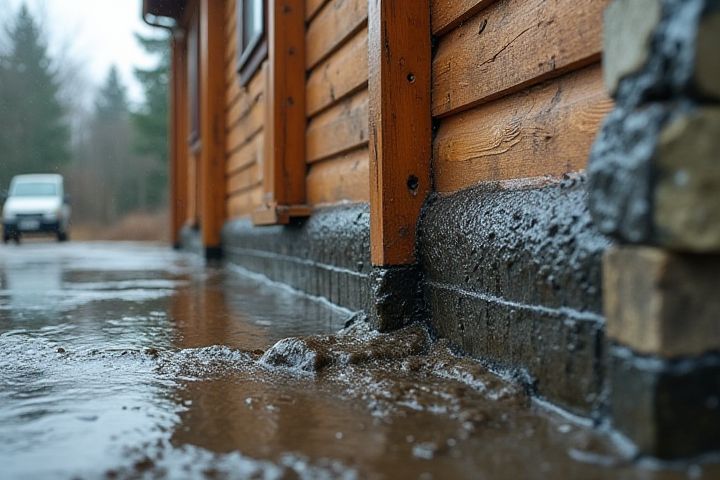
To waterproof your house in a rainy area, start by applying a high-quality sealant to all exterior surfaces, including brick, wood, and concrete, to create a barrier against moisture. Inspect and repair any cracks in the foundation using hydraulic cement, which expands and seals gaps effectively. Ensure gutters and downspouts are functioning well; divert rainwater away from the foundation by extending downspouts at least 6 feet. Consider adding a vapor barrier in crawl spaces or basements, using polyethylene sheeting to prevent moisture infiltration. Lastly, landscaping elements such as graded soil and drainage swales can help redirect rainfall away from your home.
How To Waterproof A House In A Rainy Area
Install proper drainage systems
To waterproof a house in a rainy area, installing proper drainage systems is crucial to prevent water accumulation around the foundation. A well-designed drainage system often includes French drains, which are typically composed of perforated pipes surrounded by gravel that direct water away from the house. Additionally, consider downspouts and gutters that should be extended at least 6 feet from the foundation to ensure efficient water flow. Regular maintenance of these drainage systems, including the clearing of debris, is essential to maintain their effectiveness and protect your home from water damage.
Seal windows and doors
To waterproof your house in a rainy area, begin by carefully inspecting window and door frames for gaps, cracks, or deteriorating caulk. Use a high-quality silicone or polyurethane caulk to seal these openings, ensuring a tight barrier against moisture intrusion. Consider applying weatherstripping around doors and windows to further enhance their resistance to water. Regular maintenance, including periodic checks and reapplication of sealants, will help maintain the integrity of your waterproofing efforts and protect your home from water damage.
Use waterproof coatings on exterior walls
Using waterproof coatings on exterior walls is crucial for protecting your house in a rainy area. High-quality elastomeric coatings can create a flexible, seamless barrier that repels water, preventing leaks and moisture infiltration. Ensure to apply at least two coats for optimal thickness, which can range from 10 to 20 mils to achieve effective waterproofing. Investing in specialized products, like silane or siloxane-based sealants, can enhance durability and extend the lifespan of your home's protective layer.
Ensure roof is leak-proof
A leak-proof roof is essential for waterproofing your house in a rainy area, as it prevents water infiltration that can lead to structural damage. Begin by inspecting the roof for damaged shingles or tiles, as even a small breach can allow significant water to seep in. Applying a high-quality roof sealant or waterproof membrane can enhance protection against heavy rainfall, especially in areas prone to severe weather. Regular maintenance, including cleaning gutters and downspouts, ensures effective water drainage, further safeguarding your home.
Implement a slope away from the foundation
Implementing a slope away from the foundation is crucial for effective waterproofing in a rainy area. A slope of at least 6 inches over the first 10 feet can significantly redirect water away from your home, reducing the risk of flooding and moisture damage. Ensure that the grading of soil is properly adjusted, considering drainage options like swales orFrench drains for optimal water diversion. Maintaining this slope not only protects your foundation but also enhances the longevity of your home's structural integrity.
Install gutter and downspout systems
Installing gutter and downspout systems is essential for waterproofing your house in a rainy area. Ensure that your gutters are made from durable materials such as aluminum or vinyl, and install them with a slope of 1/4 inch for every 10 feet to facilitate proper drainage. Position downspouts at least 5 to 10 feet away from the foundation to redirect water flow and prevent erosion or water pooling around your home. Regular maintenance, including cleaning leaves and debris, can significantly enhance the efficiency of your gutter system, reducing the risk of water damage.
Use moisture-resistant materials
Using moisture-resistant materials is crucial for waterproofing your house in a rainy area. Opt for high-quality materials such as fiber cement siding, which is resistant to moisture and decay, or vinyl siding that provides an additional protective layer against water intrusion. Additionally, consider installing treated wood, which has been chemically modified to repel moisture, and advanced sheathing products that offer enhanced water resistance. By prioritizing these materials, you can significantly reduce the risk of water damage and mold growth, ensuring your home remains safe and dry.
Inspect and repair any cracks or gaps
Inspect your home for any visible cracks or gaps in the foundation, walls, and around windows and doors. Use a concrete sealant for horizontal surfaces and a quality exterior caulk to fill vertical seams. Ensure the repairs are done with materials rated for wet conditions to enhance durability. Regularly checking these areas, at least twice a year or after severe weather, can prevent water intrusion and costly damage.
Utilize sump pumps in basements
Utilizing sump pumps in basements is crucial for waterproofing homes in rainy areas. A high-quality sump pump can remove excess groundwater, preventing flooding and dampness, thus protecting your foundation. Installing a sump pump with a backup power source ensures that it operates even during power outages, keeping your basement dry, with many models capable of handling up to 2,500 gallons per hour. Regular maintenance, including checking the pump's functionality and clearing any debris from the sump pit, enhances its longevity and effectiveness in safeguarding your property.
Apply water-resistant sealants around vents and pipes
To waterproof your house in a rainy area, applying water-resistant sealants around vents and pipes is essential. Start by thoroughly cleaning the surfaces to ensure proper adhesion of the sealant. Choose high-quality, mold-resistant sealants designed for exterior use, such as silicone or polyurethane options, to withstand harsh weather conditions. After application, monitor these areas regularly for wear and reapply as necessary to maintain effective moisture protection, safeguarding your home from water damage.
